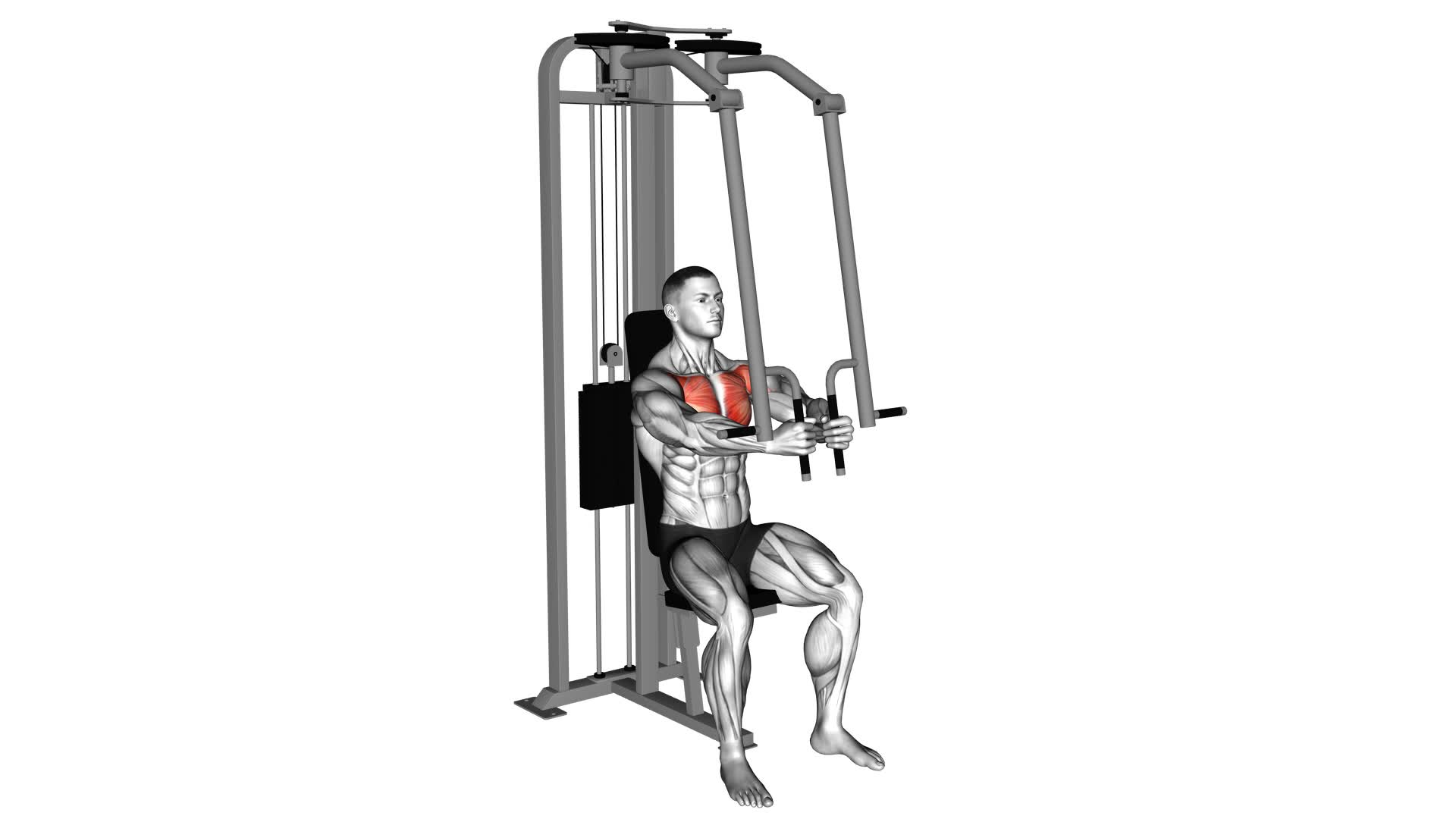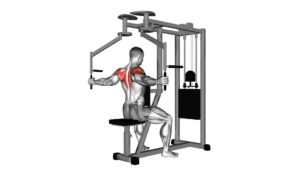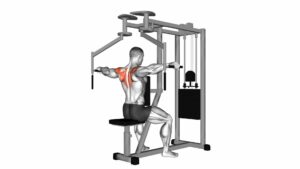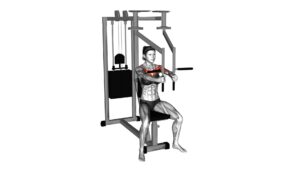Lever Seated Fly – Video Exercise Guide & Tips

Looking to strengthen your upper body and improve your posture? The Lever Seated Fly is the exercise for you. In this video exercise guide, we'll show you the proper form and technique, as well as variations and modifications to suit your fitness level.
Watch This Exercise Video
Avoid common mistakes and maximize your results with our expert tips. Get ready to feel the burn and achieve a stronger, more sculpted upper body with the Lever Seated Fly.
Let's get started!
Key Takeaways
- The Lever Seated Fly targets the chest and shoulder muscles.
- It improves upper body strength and definition.
- The exercise activates the trapezius muscles for better posture.
- Performing the Lever Seated Fly reduces the risk of shoulder injuries and mimics movement patterns required in sports.
Benefits of the Lever Seated Fly
What are the benefits of the Lever Seated Fly for you?
The Lever Seated Fly is an effective exercise that targets the muscles in your chest and shoulders. By performing this exercise, you can experience several benefits that can enhance your overall fitness and strength training routine.
One of the primary benefits of the Lever Seated Fly is the muscle activation it provides. This exercise specifically targets the pectoralis major, which is the main muscle of the chest, and the deltoids, which are the muscles located in the shoulders. By engaging these muscles, you can improve your upper body strength and definition.
Additionally, the Lever Seated Fly also activates the trapezius muscles in the upper back, helping to improve posture and reduce the risk of shoulder injuries. This exercise can also be beneficial for individuals who want to enhance their athletic performance, as it mimics the movement patterns required in many sports.
Equipment Needed for the Lever Seated Fly
To perform the Lever Seated Fly exercise, there are a few essential pieces of equipment you'll need.
First, you'll need a lever machine, which is specifically designed for this exercise.
Additionally, you'll need a weight stack or weight plates to adjust the resistance according to your fitness level.
If you don't have access to a lever machine, there are alternative exercises and equipment options you can explore to target the same muscle groups.
Essential Equipment for Fly
You'll need a few key pieces of equipment to perform the lever seated fly exercise effectively.
The first and most important piece of equipment is the lever seated fly machine. This machine typically consists of a padded seat, a lever arm, and a set of handles or pads. The lever arm allows you to adjust the resistance, making it easier or harder to perform the exercise. Additionally, you may need to adjust the seat height and the position of the handles or pads to suit your body size and comfort level.
It's also worth noting that there are different variations of the fly exercise, such as the dumbbell fly or cable fly, which require different equipment.
Transitioning into the next section, if you don't have access to a lever seated fly machine, there are alternatives to traditional equipment that you can use to target the same muscles.
Alternatives to Traditional Equipment
If you don't have access to a lever seated fly machine, there are alternative equipment options to target the same muscles. Here are some options to consider:
- Resistance band exercises: Resistance bands are a versatile and portable option that can be used to mimic the movement of the lever seated fly. Attach the resistance band to a sturdy anchor point and hold the handles in each hand. Stand with your feet shoulder-width apart and perform the fly motion by bringing your arms out to the sides, squeezing your shoulder blades together.
- Bodyweight exercises: You can also target the same muscles with bodyweight exercises such as push-ups or chest dips. Push-ups engage the chest, shoulders, and triceps, while chest dips primarily target the chest and triceps. These exercises can be modified to increase or decrease the level of difficulty based on your fitness level.
Remember to maintain proper form and technique to ensure you're effectively targeting the muscles.
Proper Form and Technique for the Lever Seated Fly
When performing the Lever Seated Fly, it's important to maintain proper form and technique to maximize the effectiveness of the exercise. Proper form not only ensures that you're targeting the intended muscles but also helps prevent injuries. One of the benefits of proper form is that it allows you to fully engage your back muscles, specifically the rhomboids and rear deltoids. By keeping your back straight and shoulders pulled back, you can effectively isolate these muscles and promote better muscle activation.
To maintain proper form during the Lever Seated Fly, avoid common mistakes such as using too much weight, which can lead to improper form and potential strain on your muscles. It's important to start with a weight that allows you to perform the exercise with proper technique. Additionally, avoid rounding your shoulders or hunching forward, as this can put unnecessary stress on your spine and decrease the effectiveness of the exercise.
Another common mistake is using momentum to complete the movement. Instead, focus on controlled and deliberate movements throughout the exercise. By maintaining a slow and controlled motion, you can ensure that you're properly engaging the targeted muscles and maximizing the benefits of the exercise.
Variations and Modifications of the Lever Seated Fly
To further enhance the effectiveness of the Lever Seated Fly, there are various variations and modifications you can incorporate into your workout routine. These variations and modifications target different muscle groups and provide a fresh challenge to your fitness regimen. Here are three options to consider:
- Single-Arm Lever Seated Fly: Instead of using both arms simultaneously, perform the exercise with one arm at a time. This variation increases the demand on your core muscles for stability and allows you to focus on each side individually.
- Reverse Grip Lever Seated Fly: Change your grip by placing your palms facing downward on the handles instead of upward. This modification targets your rear deltoids and upper back muscles more intensely.
- Incline Lever Seated Fly: Adjust the seat to an inclined position, which changes the angle of the exercise and places more emphasis on your upper chest muscles. This modification is especially beneficial if you want to develop a well-rounded chest.
Common Mistakes to Avoid During the Lever Seated Fly
To optimize your results with the Lever Seated Fly, it's crucial to avoid common mistakes that can hinder your progress. One of the most common mistakes is using improper form. It's important to maintain a proper posture throughout the exercise. Keep your back straight, shoulders relaxed, and engage your core. Avoid rounding your shoulders or hunching forward, as this can place unnecessary strain on your back and shoulders.
Another common mistake is using excessive weight. Remember, the goal of this exercise is to target the muscles in your chest and shoulders, not to lift the heaviest weight possible. Using too much weight can lead to poor form and increase the risk of injury. Start with a lighter weight and gradually increase as your strength improves.
It is also important to avoid swinging or using momentum to lift the weight. This not only takes away from the effectiveness of the exercise but also increases the risk of injury. Instead, focus on using controlled movements, keeping the tension on your chest and shoulders throughout the entire range of motion.
Lastly, avoid rushing through the exercise. Take your time to perform each repetition with proper form and control. This will ensure that you're targeting the intended muscles and maximizing your results.
Tips for Maximizing Your Results With the Lever Seated Fly
To maximize your results with the Lever Seated Fly, focus on maintaining proper form and engaging the targeted muscles. Here are some tips and tricks to help you get the most out of this exercise:
- Start by adjusting the seat height so that your feet are flat on the ground and your knees are at a 90-degree angle. This will provide a stable base of support and allow for proper alignment.
- Grab the handles of the lever machine with an overhand grip, keeping your wrists straight and your elbows slightly bent. This will help you maintain control throughout the movement.
- Keep your back straight and your core engaged throughout the exercise. Avoid arching or rounding your back, as this can put unnecessary strain on your spine.
- Focus on squeezing your shoulder blades together as you bring the handles towards the center of your body. This will activate the muscles in your upper back and help to improve posture.
- Control the movement on both the eccentric and concentric phases. Avoid using momentum to swing the handles, as this will diminish the effectiveness of the exercise.
- Experiment with different fly variations, such as a wide grip or a narrow grip, to target different areas of your back and shoulders.
- Remember to breathe throughout the exercise, exhaling as you bring the handles together and inhaling as you return to the starting position.
Frequently Asked Questions
How Long Should I Rest Between Sets When Performing the Lever Seated Fly?
When performing the lever seated fly, it's important to consider the rest intervals between sets. Resting for the right amount of time allows your muscles to recover and prepares them for the next set.
The duration of rest between sets can vary depending on your goals and fitness level. It's generally recommended to rest for around 30 to 90 seconds between sets to optimize muscle activation and performance.
Can the Lever Seated Fly Help Improve My Posture?
The lever seated fly is a great exercise to improve your posture and strengthen your upper back. By performing this exercise, you can target the muscles in your upper back, including the rhomboids and rear deltoids, which play a crucial role in maintaining proper posture.
The lever seated fly helps to open up your chest and pull your shoulders back, promoting a more upright and aligned posture. Regularly incorporating this exercise into your routine can lead to significant improvements in your overall posture.
Is the Lever Seated Fly Suitable for Beginners or Is It More Advanced?
The lever seated fly can be a challenging exercise, especially for beginners. It requires proper form and technique to avoid injury. However, there are modifications that can make it more suitable for beginners, such as using lighter weights or adjusting the seat position.
If you find the lever seated fly too advanced, there are alternative exercises that target the same muscles, such as dumbbell flies or resistance band chest flies. These exercises can help you build strength gradually.
Can the Lever Seated Fly Help With Strengthening the Muscles in the Upper Back?
The lever seated fly is a great exercise for strengthening the muscles in your upper back. It targets the rhomboids and rear deltoids, helping to improve posture and upper body strength.
If you're looking for alternative workouts to target these muscles, you can also try exercises like bent over rows or reverse flies. These strengthening exercises will help you build a strong and stable upper back, improving your overall fitness and preventing injuries.
Are There Any Specific Breathing Techniques I Should Follow While Performing the Lever Seated Fly?
When performing the lever seated fly, it's important to pay attention to your breathing techniques. Proper breathing can enhance the effectiveness of this exercise.
Remember to inhale as you bring the handles together in front of your chest and exhale as you return to the starting position. This controlled breathing pattern helps engage the targeted muscles in your upper back and promotes stability throughout the movement.
Keep practicing and focus on your breath to maximize the benefits of the lever seated fly.
Conclusion
In conclusion, the Lever Seated Fly is a highly effective exercise for targeting the muscles in your chest and shoulders. By using the proper form and technique, you can maximize your results and avoid common mistakes.
Whether you're a beginner or advanced fitness enthusiast, this exercise can be modified to suit your needs. Incorporating the Lever Seated Fly into your workout routine can help you achieve a stronger and more defined upper body.

Author
Years ago, the spark of my life’s passion ignited in my mind the moment I stepped into the local gym for the first time. The inaugural bead of perspiration, the initial endeavor, the very first surge of endorphins, and a sense of pride that washed over me post-workout marked the beginning of my deep-seated interest in strength sports, fitness, and sports nutrition. This very curiosity blossomed rapidly into a profound fascination, propelling me to earn a Master’s degree in Physical Education from the Academy of Physical Education in Krakow, followed by a Sports Manager diploma from the Jagiellonian University. My journey of growth led me to gain more specialized qualifications, such as being a certified personal trainer with a focus on sports dietetics, a lifeguard, and an instructor for wellness and corrective gymnastics. Theoretical knowledge paired seamlessly with practical experience, reinforcing my belief that the transformation of individuals under my guidance was also a reflection of my personal growth. This belief holds true even today. Each day, I strive to push the boundaries and explore new realms. These realms gently elevate me to greater heights. The unique combination of passion for my field and the continuous quest for growth fuels my drive to break new ground.







